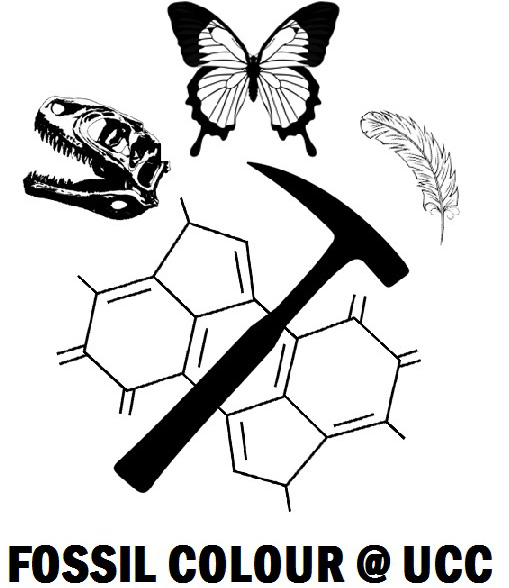Projects
About our research
In broad terms, my research group tries to answer these questions:
- How much can we trust the fossil record?
- Are some aspects of the fossil record more or less trustworthy than others?
- What factors skew the fossil record of ancient life?
- What “extra” information can soft tissues give us?
- How can we figure all this out?
We are especially interested in the preservation of non-biomineralised ‘soft’ tissues (e.g. integument, muscle, internal organs) in fossils, and what these exceptional fossil remains tell us about the anatomy, physiology, ecology and behaviour of ancient animals.
Over the last ten years or so a major focus of our research has been the taphonomy of colour in fossil animals. We are interested in the preservation, evolutionary origins and functions of structural and pigmentary coloration in various animal groups, in particular, insects and feathered taxa, throughout the Phanerozoic.
We’re also working hard on understanding the evolution of the integument – tissues such as feathers, skin, etc. – because it defines how vertebrates live their lives on land.
Ultimately we’re interested in fossil preservation, so we also study fossils in large numbers from certain biotas.
The research we do here in Cork is very analytical. We use both fossils and experiments to investigate the processes of soft tissue degradation and preservation. By understanding the various biological, sedimentological and diagenetic factors that control soft tissue preservation, we can begin to tease apart patterns (biases) in the fossil record.
Our fossil-based research leans heavily on electron microscopy and synchrotron-X-ray analyses to better understand the ultrastructure and chemistry of fossil tissues. However we are now also increasingly supporting these data with vibrational spectroscopy (FTIR and Raman) – work in progress! Plus we like to back up our fossil work with rigorous statistical analysis of taphonomic data.
What have we learned from fossils?
- Your inner pigment: vertebrates have lots of melanosomes in their internal organs (see news reports here: 1, 2, 3, 4, 5, 6, 7, 8, 9, 10, 11, 12, 13, 14)
- Melanin in the driving seat: melanin pigments are intimately involved in major transitions in vertebrate evolution, e.g. evolution of endothermy, hair and feathers, and this goes hand-in-hand with evolution of immunity and behaviour (see news reports here: 1)
- Metal anatomy: We can analyse the metal chemistry of melanosomes in fossils to work out the tissue anatomy of ancient creatures
- Smells like a squid?: The weird fossil enigma Tullimonstrum has melanosomes that (in chemical terms) don’t look like vertebrate examples (see news reports here: 1, 2, 3, 4, 5, 6, 7, 8)
- Fluffy pterosaurs: these flying beasts had feathers over 70 million years before birds and dinosaurs (see news reports here: 1, 2, 3, 4, 5, 6, 7, 8, 9, 10, 11, 12, 13)
- Sneaky snakes: Some fossil snakes had blotchy green patterns for camouflage (see news reports here: 1, 2, 3, 4, 5, 6, 7)
- Shiny happy beetles: fossil beetles from the Cenozoic preserve real structural colours (biophotonic crystals), including fabulous single diamond 3D photonic crystals (see news reports here: 1, 2, 3, 4, 5)
- Keeping their colours: some fossil moths living during the Eocene and Jurassic had colours (and colour-producing structures) that their living relatives still show today (see news reports here: 1, 2, 3, 4, 5, 6)
- Many well-preserved fossil frogs had tough mineral-rich skin that helped preservation (see news reports here: 1)
- Even very decay-prone soft tissues like muscle and bone marrow can preserve as organic (carbon-based) molecules in fossils (see news reports here: 1, 2, 3)
Our experimental research involves simulating aspects of the fossilization process in the lab. We are not making fossils! Neither are we trying to replicate ancient fossil-creating environments! Instead we isolate parameters (e.g. temperature, pH) and study how these affect decay and preservation. We run some experiments at room temperatures and pressures to study decay. We run other experiments at elevated temperatures and pressures to understand how biological tissues transform to geomacromolecules as they are cooked during the burial part of the fossilization process.
What have we learned from experiments?
- Chemical chimeras: Melanosomes can take up metals during diagenesis, changing their original chemistry
- Convergent chemistry: Melanosomes from certain tissues are more prone to chemical change than others, and converge in chemistry during fossilization
- Disappearing melanosomes: Melanosomes are destroyed when fossils are oxidised, generating melanosome “ghosts” (moulds)
- Honey I shrunk the melanosomes: Melanosomes shrink when heated, potentially affecting colour reconstructions
- The blue problem: Many fossil insects are blue (and not green like today) because their structural colours have been blueshifted by the effects of heat and pressure (see news reports here: 1, 2, 3)
Our research is currently funded through the following projects:
- IRC awards (Postgraduate scholarships and Postdoctoral Fellowships)
- SFI awards through the Discover, Frontiers for the Future, and iCRAG-GSI Environmental Geoscience programmes
- ERC Consolidator Grant (more info here)
Previous funders: ERC Starting Grant (more info here), Marie Curie Career Integration Grant, Marie Curie International Fellowship.


